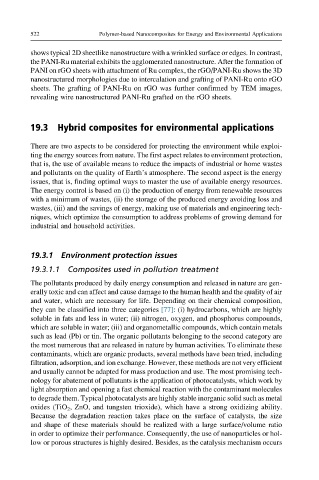Page 569 - Polymer-based Nanocomposites for Energy and Environmental Applications
P. 569
522 Polymer-based Nanocomposites for Energy and Environmental Applications
shows typical 2D sheetlike nanostructure with a wrinkled surface or edges. In contrast,
the PANI-Ru material exhibits the agglomerated nanostructure. After the formation of
PANI on rGO sheets with attachment of Ru complex, the rGO/PANI-Ru shows the 3D
nanostructured morphologies due to intercalation and grafting of PANI-Ru onto rGO
sheets. The grafting of PANI-Ru on rGO was further confirmed by TEM images,
revealing wire nanostructured PANI-Ru grafted on the rGO sheets.
19.3 Hybrid composites for environmental applications
There are two aspects to be considered for protecting the environment while exploi-
ting the energy sources from nature. The first aspect relates to environment protection,
that is, the use of available means to reduce the impacts of industrial or home wastes
and pollutants on the quality of Earth’s atmosphere. The second aspect is the energy
issues, that is, finding optimal ways to master the use of available energy resources.
The energy control is based on (i) the production of energy from renewable resources
with a minimum of wastes, (ii) the storage of the produced energy avoiding loss and
wastes, (iii) and the savings of energy, making use of materials and engineering tech-
niques, which optimize the consumption to address problems of growing demand for
industrial and household activities.
19.3.1 Environment protection issues
19.3.1.1 Composites used in pollution treatment
The pollutants produced by daily energy consumption and released in nature are gen-
erally toxic and can affect and cause damage to the human health and the quality of air
and water, which are necessary for life. Depending on their chemical composition,
they can be classified into three categories [77]: (i) hydrocarbons, which are highly
soluble in fats and less in water; (ii) nitrogen, oxygen, and phosphorus compounds,
which are soluble in water; (iii) and organometallic compounds, which contain metals
such as lead (Pb) or tin. The organic pollutants belonging to the second category are
the most numerous that are released in nature by human activities. To eliminate these
contaminants, which are organic products, several methods have been tried, including
filtration, adsorption, and ion exchange. However, these methods are not very efficient
and usually cannot be adapted for mass production and use. The most promising tech-
nology for abatement of pollutants is the application of photocatalysts, which work by
light absorption and opening a fast chemical reaction with the contaminant molecules
to degrade them. Typical photocatalysts are highly stable inorganic solid such as metal
oxides (TiO 2 , ZnO, and tungsten trioxide), which have a strong oxidizing ability.
Because the degradation reaction takes place on the surface of catalysts, the size
and shape of these materials should be realized with a large surface/volume ratio
in order to optimize their performance. Consequently, the use of nanoparticles or hol-
low or porous structures is highly desired. Besides, as the catalysis mechanism occurs

